 The MGM Records Story
The MGM Records StoryMetro-Goldwyn-Mayer (MGM), of course, was a movie industry giant for several decades when
MGM Records was founded in late 1946. This was primarily for release of MGM movie soundtracks, but
widened to all musical genres in the following years with some accent on country & western. Hank
Williams recorded eleven songs which sold more than a million times each between the years of 1949
and 1953. In the early 1950s, MGM Records was considered as one of the "major" record companies
(besides Columbia, RCA, Decca, Capitol and Mercury) because it had its own manufacturing facilities.
MGM issues thousands of singles, EPs, and albums from it's birth in 1946 until it was subsumed into
PolyGram in the mid-1970s. Most successful performers during the 1950s were Connie Francis, Hank
Williams and Conway Twitty.
The 1950s were a time of expansion for MGM. The record-buying public was being offered music on a
wide array of different formats, from the traditional 78 rpm singles and albums, to the 45 rpm singles and
albums, to extended play 45 rpm "EP" records and albums, to 10-inch, 33-1/3 rpm albums, and finally, to
the eventual winner in the format sweepstakes, the 12-inch, 33-1/3 rpm album. A look through the
discographies shows that in 1954-55, particularly, MGM was releasing the same music in virtually all
formats. By late 1955, the 10-inch LP was falling out of favor relative to it's larger counterpart, and was
discontinued shortly thereafter. Likewise, the "EP album," made up of several EP records in an album
with sleeves for each record, was essentially discontinued in 1956, although a few were issued later.
The EP itself followed into extinction in the early 1960s, although a few were issued as late as 1963.
In 1961, MGM bought Norman Granz' highly succesful Verve label, which was one of the first names in
jazz. During the 1960s, MGM extended Verve with a rock line featuring such fine names as The
Righteous Brothers, The Velvet Underground and The Mothers Of Invention.
Obviously, the rock music of the 1960s always was a serious problem for MGM Records, as most of the
performers were said to be very unhappy with the label. MGM allegedly censored their songs, released
albums without knowledge of the artists, or suppressed them. MGM was considered to buy performers
away from other labels rather than to build up new talents. During the mid-'60s MGM distributed the
newly founded Kama Sutra label (most successful with The Lovin' Spoonful).
When "acid rock" hit the scene in 1968, Eric Burdon & The Animals were MGM's sole participation in the
genre. In 1968-69, MGM tried to hype groups from Boston ("Bosstown Rock") to repeat the success of
Detroit rock groups, but failed. In the fiscal years 1968 and 1969, MGM Records took losses of $18
million, and in 1970 and 1971 they just broke even. The reasons given for such poor showings were the
failed Bosstown Campaign ($4 million loss) and contractual difficulties with unsuccessful independent
producers. As Metro-Goldwyn-Mayer, Inc. still planned unrealistic sales figures for their record division,
MGM Records had big problems with unsold records from the stores, which led to masses of cutouts.
Under MGM executive Mike Curb (later to be Lieutenant Governor of California), in 1970 MGM fired 18
groups from its roster who had publicized the use of drugs in their songs. Actually, this was an excuse to
get rid of some unsuccessful acts, since popular performers like Eric Burdon or Bobby Bloom, who did
the same thing, were kept by the label. President Nixon praised Mike Curb because of his unrelenting
attitude against drug abuse.
During the early 1970s, MGM filled up its performers with family entertainers and "bubblegum" acts like
Sammy Davis, Jr., Petula Clark and The Osmonds, which were extremely successful in domestic and
overseas markets, helping the label to right itself financially.
In 1972, the label was sold to the newly-founded Dutch-German conglomerate PolyGram (Polydor and
Phonogram), which tried to get a share of the American market by buying US record companies.
PolyGram tried to re-establish MGM as a mainstream rock label, but failed. As with most such 1970s
takeovers, the new European management didn't understand the US market. As of 1976, the now
Polydor-distributed label was only used for the release of soundtrack albums from MGM films. After the
merger of Metro-Goldwyn-Mayer, Inc. and United Artists Corporation in 1982, the label was discontinued
altogether, although a few soundtrack albums were released in 1983/84 which carried a small MGM/UA
Home Entertainment logo on its sleeves and labels.
MGM material has been re-released by several companies. Popular stuff from the '60s was released on
Polydor (Eric Burdon, Connie Francis, Hank Williams). Material from the Mike Curb era has also been
re-released on his own label, Curb Records (primarily the Osmonds). The popular MGM
soundtracks were combined with United Artists soundtracks and sold outright to CBS/Columbia
and MCA Records in the '80s and early '90s. In 1986, MCA issued around 100 soundtracks from the
combined MGM/UA catalogue, for the last time on vinyl. In recent years, Rhino Records (via its Turner
Classic Movies label) re-released classic soundtracks from the MGM vaults on collectable CD issues
featuring previously unreleased bonus tracks.
The MGM label design had very few major changes over the thousands of records released. In the
1940s and until 1959, the label was yellow with the famous lion logo in black, with black lettering. This
label was used in the UK until the mid-'60s. From 1959 to 1968, MGM used a black label with the classic
Metro-Goldwyn-Mayer Lion logo and rainbow colored "M-G-M" on top of the label, with additional
lettering in silver. In 1968, the label became half blue, half gold (later the gold
color was changed to some yellowish beige), with the lion logo (in black) and "MGM Records" (in blue) to
its right side, all on gold/beige, rest of the lettering was in black.
Early records noted that MGM was a division of Loewe's, Incorporated. From the early 1960s until
approximately 1971, labels read at the bottom "M-G-M Records - A Division Of Metro-Goldwyn-Mayer,
Inc.", later this became "Manufactured by MGM Records, Inc., 7165 Sunset Boulevard, Hollywood, Calif.
90046". From approx. 1976, the bottom lettering read "Manufactured And Marketed By Polydor
Incorporated/810 Seventh Avenue/New York/N.Y. 10019".
This discography was constructed with the use of our record collections, Schwann Catalog
listings, and the book The MGM Labels: A Discography by Michel Ruppli and Ed Novitsky
(Greenwood Press, 1998). Billboard chart positions are from Joel Whitburn's Top Pop Albums
1955-1992 and Top Country Albums 1964-1997.
We would appreciate any additions or corrections to this discography. Just send them to us via e-mail. Both Sides Now
Publications is an information web page. We are not a catalog, nor can we provide the records listed
below. We have no association with MGM Records or Universal Music Group, who currently owns the
MGM masters. Should you be interested in acquiring albums
listed in this discography (which are all out of print), we suggest you see our Frequently Asked Questions page and follow the
instructions found there. This story and discography are copyright 2000 by Mike Callahan.
 MGM Records Story
MGM Records Story
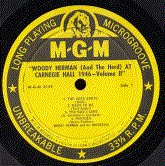 MGM Album Discography, Part 1 10-inch Albums
MGM Album Discography, Part 1 10-inch Albums
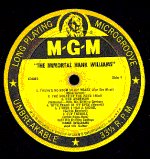 MGM Album Discography, Part 2 E-3000 to E-
3200 (1953-1955)
MGM Album Discography, Part 2 E-3000 to E-
3200 (1953-1955)
 MGM Album Discography, Part 3 E-3201 to E-
3400 (1955-1956)
MGM Album Discography, Part 3 E-3201 to E-
3400 (1955-1956)
 MGM Album Discography, Part 4 E-3401 to E-3600
(1956-1957)
MGM Album Discography, Part 4 E-3401 to E-3600
(1956-1957)
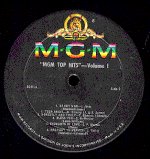 MGM Album Discography, Part 5 E-3601 to E-
3800 (1957-1960)
MGM Album Discography, Part 5 E-3601 to E-
3800 (1957-1960)
 MGM Album Discography, Part 6 E-3801 to E-
4000 (1960-1962)
MGM Album Discography, Part 6 E-3801 to E-
4000 (1960-1962)
 MGM Album Discography, Part 7 E-4001 to E-
4200 (1962-1964)
MGM Album Discography, Part 7 E-4001 to E-
4200 (1962-1964)
 MGM Album Discography, Part 8 E-4201 to E-
4400 (1964-1966)
MGM Album Discography, Part 8 E-4201 to E-
4400 (1964-1966)
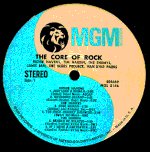 MGM Album Discography, Part 9 SE-4401 to SE-
4600 (1966-1969)
MGM Album Discography, Part 9 SE-4401 to SE-
4600 (1966-1969)
 MGM Album Discography, Part 10 SE-4601 to SE-
4800 (1969-1972)
MGM Album Discography, Part 10 SE-4601 to SE-
4800 (1969-1972)
 MGM Album Discography, Part 11 SE-4801 to MGB-
5412 (1972-1982)
MGM Album Discography, Part 11 SE-4801 to MGB-
5412 (1972-1982)
 MGM Album Discography, Part 12 Soundtrack
Series (1960-1974)
MGM Album Discography, Part 12 Soundtrack
Series (1960-1974)
 MGM Album Discography, Part 13 Children's Records
(1962-1964)
MGM Album Discography, Part 13 Children's Records
(1962-1964)
 MGM Album Discography, Part 14 Golden Archive Series
(1970)
MGM Album Discography, Part 14 Golden Archive Series
(1970)
 MGM Album Discography, Part 15 Miscellaneous Series
MGM Album Discography, Part 15 Miscellaneous Series
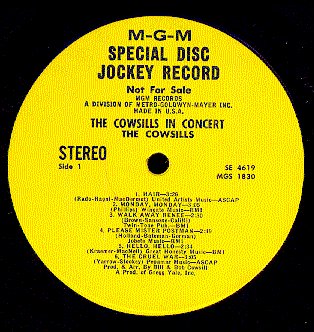 MGM Album Discography, Part 16 Deejay and Promotional
Records
MGM Album Discography, Part 16 Deejay and Promotional
Records
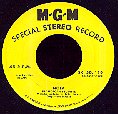 MGM Album Discography, Part 17 Stereo Singles and Little LPs
MGM Album Discography, Part 17 Stereo Singles and Little LPs
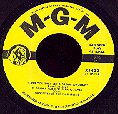 MGM Album Discography, Part 18 Extended Play 45s (X-1 Series)
Early 2-EP sets (1950-1955)
MGM Album Discography, Part 18 Extended Play 45s (X-1 Series)
Early 2-EP sets (1950-1955)
 MGM Album Discography, Part 19 Extended Play 45s (X1000
Series) Main single-EP Series (1952-1962)
MGM Album Discography, Part 19 Extended Play 45s (X1000
Series) Main single-EP Series (1952-1962)
 MGM Album Discography, Part 20 Extended Play 45s (X4000
Series) 2- and 3-EP albums
MGM Album Discography, Part 20 Extended Play 45s (X4000
Series) 2- and 3-EP albums
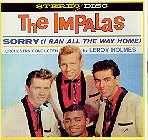 Cub Album Discography
Cub Album Discography
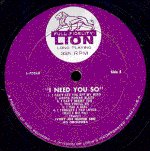 Lion Album Discography 1950s
Lion Album Discography 1950s
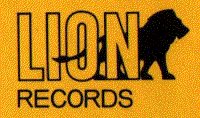 Lion Album Discography 1970s
Lion Album Discography 1970s
 Metro Album Discography
Metro Album Discography
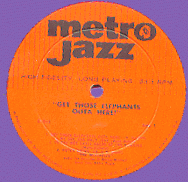 Metro Jazz Album Discography
Metro Jazz Album Discography
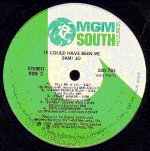 MGM South Album Discography
MGM South Album Discography
 American International Records (AIR)
American International Records (AIR) 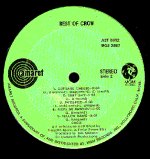 Amaret Album Discography
Amaret Album Discography
 Ava Album Discography
Ava Album Discography
 Barnaby Album Discography
Barnaby Album Discography
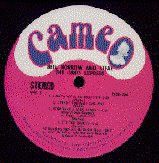 Cameo/Parkway Album Discography
Cameo/Parkway Album Discography
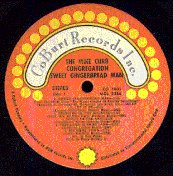 CoBurt Album Discography
CoBurt Album Discography
 Heritage Album Discography
Heritage Album Discography
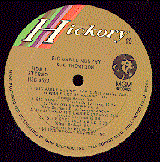 MGM/Hickory Album Discography
MGM/Hickory Album Discography
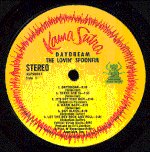 Kama Sutra Album Discography
Kama Sutra Album Discography
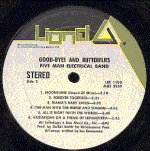 Lionel Album Discography
Lionel Album Discography
 Mine Album Discography
Mine Album Discography
 Poppy Album Discography
Poppy Album Discography
 Pride Album Discography
Pride Album Discography
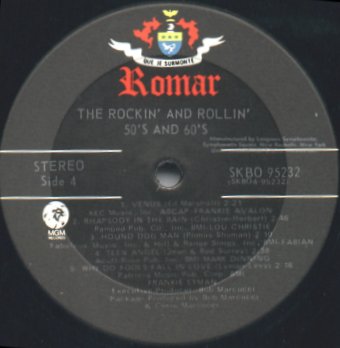 Romar Album Discography
Romar Album Discography
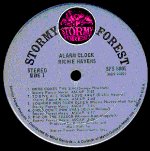 Stormy Forest Album Discography
Stormy Forest Album Discography
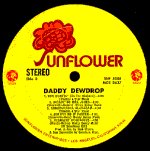 Sunflower Album Discography
Sunflower Album Discography
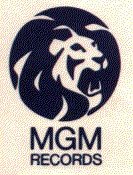 Miscellaneous MGM-Distributed Labels MGM/Griffin,
MGM/Latino,
Attarack,
BBC, Charter, Flick Disc, Jolly Rogers, Lamb & Lion, Lyra, Marina, Merlin/MGM, Music Factory,
Palette, Quad, Ramrod, Sounds of Memphis, Vando
Miscellaneous MGM-Distributed Labels MGM/Griffin,
MGM/Latino,
Attarack,
BBC, Charter, Flick Disc, Jolly Rogers, Lamb & Lion, Lyra, Marina, Merlin/MGM, Music Factory,
Palette, Quad, Ramrod, Sounds of Memphis, Vando
 Back to the Discography Listings Page
Back to the Discography Listings Page  Back to the Both Sides Now Home Page
Back to the Both Sides Now Home Page